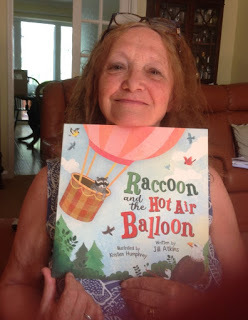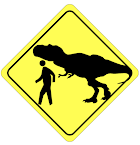Moira Butterfield's Blog, page 15
September 5, 2021
Paper, pencils and picture book ideas by Jane Clarke
Chitra recently contributed a great step by step post How to edit picture book texts without cutting trees and I intend to try her method the next time I attempt to put a picture book text into pages. But when I'm working on a new idea, it never starts off on the computer. I'm not advocating the destruction of forests, but at the outset, paper, pencils and picture book ideas go together for me.
Working this way is an excuse to buy notebooks. And pencils. And stuff like sticky notes. Even if the ideas in them get outdated, the notebooks don't become obsolete and are easy to access.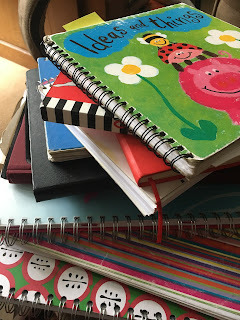 I have LOTs of notebooks filled full of half-baked ideas. I’m not that fussy about notebooks. Some caught my eye, but I’ve been through a lot of cheap spiral bound notebooks. The posh Moleskine one was a gift.
I have LOTs of notebooks filled full of half-baked ideas. I’m not that fussy about notebooks. Some caught my eye, but I’ve been through a lot of cheap spiral bound notebooks. The posh Moleskine one was a gift. Working with paper and pencil feels free-er and more creative than screen and keyboard. There’s something just too neat and tidy and regimented about computer text.
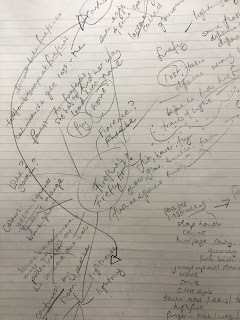 Mind map of what became Firefly Home. Messy handwriting with lots of crossing out happens in my notebooks.
Mind map of what became Firefly Home. Messy handwriting with lots of crossing out happens in my notebooks.
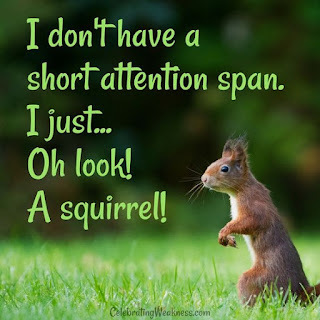 Squirrel! moments on the computer are lots of fun, but make it hard to concentrate on one idea at a time.
Squirrel! moments on the computer are lots of fun, but make it hard to concentrate on one idea at a time.
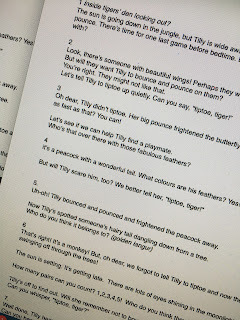 Tidy text of Tiptoe Tiger
Tidy text of Tiptoe TigerIf a picture book text is taken by an editor, all future work on it will be on the computer - electronic versions will whiz back and forth by email. Which brings me to my final point in favour of paper, pencils and picture book ideas:
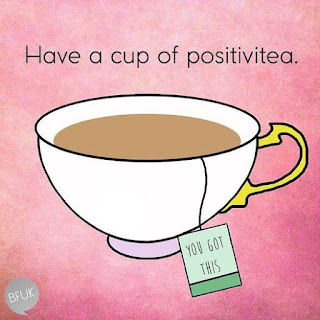
Jane’s latest picture book is Tiptoe Tiger, gloriously illustrated by Britta Teckentrup, and published by Nosy Crow.
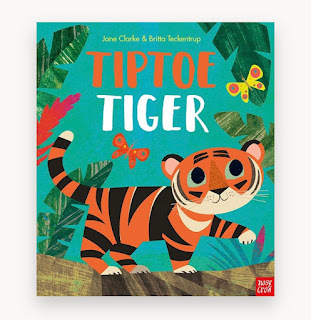
August 23, 2021
Not Just a Jealous Guy - Gareth P Jones
If you are an author, there is a good chance you have some presence on social media. If you’re anything like me, you have found that your life online became a considerably more significant aspect of your life over the course of the pandemic.
Twitter is my social media site of choice. Most of the time, I find it a great way of making friends, maintaining friendships, making silly jokes, feeling connected, promoting books and finding work. But the subject of this blog is one aspect of being an author online that is harder to talk about because it involves a personality trait that I am ashamed of. I’m talking about Jealousy.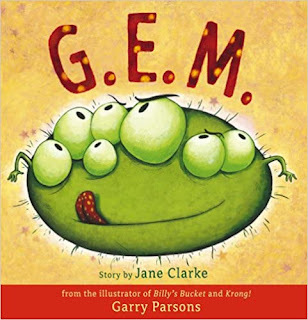
In G.E.M. by Jane Clarke and Garry Parsons, Royd has a Green Eyed Monster, which gets bigger and bigger until it eventually consumes him.
As my twitter friend, Elon Dann points out, there is a difference between jealousy and envy. As he puts it, “Jealousy is insecurity about a potential loss. Envy is resentful longing.”
The feeling that I’m addressing here lies somewhere between these two definitions. Insecure longing - possibly with a touch of resentful fear of potential loss.
Lots of my friends tell me they never feel this. Maybe you’re the same, in which case I am envious of your lack of jealousy.
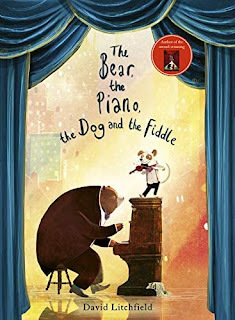
In David Litchfield’s The Bear, The Dog, The Piano and The Fiddle, Hugo the dog learns the fiddle and gets the chance to play with Bear’s Big Band but the question is whether Hugo's owner Hector can swallow his pride and learn to be for happy for his friend.
When you go online to big up your books, you are likely to encounter lots of other people doing the same. Whether you have signed a contract, received a copy of your brand-new book, found an agent, had a book published or received a glowing review, you are expected to capitalise on this positive moment. If you are appearing at a book festival or picking up a national book award, it would be stranger if you didn’t mention it on social media. As authors, we understand this and we support each other’s efforts in the hope that we can create a supportive, inclusive environment.
Happily, for the most part, we succeed in this.
There is no place for expressing jealousy in this world. Feeling it is bad enough. Voicing it is unforgivable. Sometimes it might seep out in the form of suitably vague, but snarky joke. But you’ll know what you meant – and so will others. For that reason, those who suffer from jealousy learn that it is better to bury our feelings.
We chastise ourselves for feeling this way. We tell ourselves that we have much to be grateful for and that many people’s dream is to be a children’s author. We feel embarrassed about these ugly thoughts. We feel shame that such thoughts could even cross our minds.
But jealousy is also intricately connected to ambition. Denying its existence is to ignore the positive aspect of how much it can be a motivator. My jealous thoughts remind me that I am able of doing something about my situation. I can write another book. I can send out an email or tweet to get more school bookings. I can contact a festival and offer my services. I can bribe a national book award judge with a barrel of fudge.
OK, so I have never done this last one, but my point is that, although jealousy is an unattractive quality, pretending that it isn’t there, will not make it vanish. The way I have learned (and am still learning) to deal with it is to acknowledge that it’s there, understand why it’s there, and try to find a positive side to it.
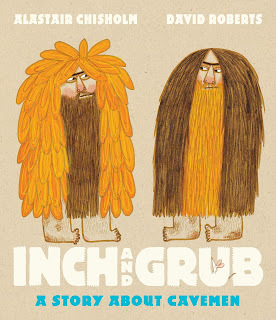
Inch and Grub (Alastair Chisholm and David Roberts) sees its two eponymous cavemen heroes coming up with increasingly impressive inventions as their competitive jealousy spurs them on.
The moral of this caveman story is that ‘stuff’ isn’t what matters, but I think it also shows how these negative feelings can lead to positive action. I do my best to hide my jealousy (except for when I’m writing a blog about it) but I also accept that it is a part of me and a part of life online. So long as it’s kept in check, it can fuel invention and motivate us to create.
Gareth P Jones' brand new picture book, Cinder Gorilla, illustrated by Loretta Schauer is published this September by Farshore Books.
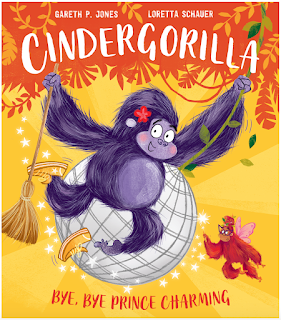
Not Just a Jealous Guy
If you are an author, there is a good chance you have some presence on social media. If you’re anything like me, you have found that your life online became a considerably more significant aspect of your life over the course of the pandemic.
Twitter is my social media site of choice. Most of the time, I find it a great way of making friends, maintaining friendships, making silly jokes, feeling connected, promoting books and finding work. But the subject of this blog is one aspect of being an author online that is harder to talk about because it involves a personality trait that I am ashamed of. I’m talking about Jealousy.
In G.E.M. by Jane Clarke and Garry Parsons, Royd has a Green Eyed Monster, which gets bigger and bigger until it eventually consumes him.
As my twitter friend, Elon Dann points out, there is a difference between jealousy and envy. As he puts it, “Jealousy is insecurity about a potential loss. Envy is resentful longing.”
The feeling that I’m addressing here lies somewhere between these two definitions. Insecure longing - possibly with a touch of resentful fear of potential loss.
Lots of my friends tell me they never feel this. Maybe you’re the same, in which case I am envious of your lack of jealousy.

In David Litchfield’s The Bear, The Dog, The Piano and The Fiddle, Hugo the dog learns the fiddle and gets the chance to play with Bear’s Big Band but the question is whether Hugo's owner Hector can swallow his pride and learn to be for happy for his friend.
When you go online to big up your books, you are likely to encounter lots of other people doing the same. Whether you have signed a contract, received a copy of your brand-new book, found an agent, had a book published or received a glowing review, you are expected to capitalise on this positive moment. If you are appearing at a book festival or picking up a national book award, it would be stranger if you didn’t mention it on social media. As authors, we understand this and we support each other’s efforts in the hope that we can create a supportive, inclusive environment.
Happily, for the most part, we succeed in this.
There is no place for expressing jealousy in this world. Feeling it is bad enough. Voicing it is unforgivable. Sometimes it might seep out in the form of suitably vague, but snarky joke. But you’ll know what you meant – and so will others. For that reason, those who suffer from jealousy learn that it is better to bury our feelings.
We chastise ourselves for feeling this way. We tell ourselves that we have much to be grateful for and that many people’s dream is to be a children’s author. We feel embarrassed about these ugly thoughts. We feel shame that such thoughts could even cross our minds.
But jealousy is also intricately connected to ambition. Denying its existence is to ignore the positive aspect of how much it can be a motivator. My jealous thoughts remind me that I am able of doing something about my situation. I can write another book. I can send out an email or tweet to get more school bookings. I can contact a festival and offer my services. I can bribe a national book award judge with a barrel of fudge.
OK, so I have never done this last one, but my point is that, although jealousy is an unattractive quality, pretending that it isn’t there, will not make it vanish. The way I have learned (and am still learning) to deal with it is to acknowledge that it’s there, understand why it’s there, and try to find a positive side to it.

Inch and Grub (Alastair Chisholm and David Roberts) sees its two eponymous cavemen heroes coming up with increasingly impressive inventions as their competitive jealousy spurs them on.
The moral of this caveman story is that ‘stuff’ isn’t what matters, but I think it also shows how these negative feelings can lead to positive action. I do my best to hide my jealousy (except for when I’m writing a blog about it) but I also accept that it is a part of me and a part of life online. So long as it’s kept in check, it can fuel invention and motivate us to create.
Gareth P Jones' brand new picture book, Cinder Gorilla, illustrated by Loretta Schauer is published this September by Farshore Books.

August 16, 2021
Could it be… ADHD? ADHD and writing by Juliet Clare Bell
I have a terrible confession to make about Picture Book Den. So we take it in turns to write blogposts each week and there’s a rota of who goes when…
only I don’t know where that rota is…
…which means I don’t know when I’m meant to post. Which means I periodically get a heart-stopping moment where I think ‘oh no [though much less politely], it might be my turn and I’ve forgotten (again)’ -but I don’t think the thought through properly enough in the run-up to the Monday when someone posts (and ignore that nagging feeling), I think it on the Monday… but I have an almost pathological fear of checking to find the rota to see if I’m right (that I’ve missed my date).
Sounds ridiculous, right? Because it is. Why don't I just write the dates on a calendar? And why would I choose to stick my head in the sand and NOT check the dates when I know that I haven't posted for ages?
And yet I do it time and time again. When someone else posts on a Monday, I breathe a sigh of relief as it can't have been my week after all... Over the years, I’ve occasionally remembered to write down my dates for the whole year onto my calendar which means I’ll get them in on time for that year -(IF I’ve remembered to look at my calendar regularly, of course) but mostly I don’t. And so, shamefully, I am reminded when I’ve already missed my deadline. It’s not that I don’t want to do it. I love being in the Picture Book Den. I’m only posting this because shame thrives on secrets (thank you, Brene Brown). I’ve got plenty of terrible confessions I could make about opportunities missed because I have huge difficulties prioritising anything, and how I can be 98% through a writing task but cannot make myself do the last two percent -for often weeks, or months, or years. But all this confession talk is working up to something that happened about four weeks ago…
It was my Usual Suspects moment (you know, when the big reveal all comes together and it’s like ‘no way! [another realisation]… no way!... [and another] no way! With each additional realisation that you’re suddenly bombarded with, you think. Wow.
Everything
suddenly
makes
sense.
It reminded me of the lightbulb moment in my most recent picture book, Ask First, Monkey! (illustrated by Abigail Tompkins). Monkey gets it wrong time and time again and doesn’t realise what he needs to do in order to work out whether someone wants to be tickled or not.
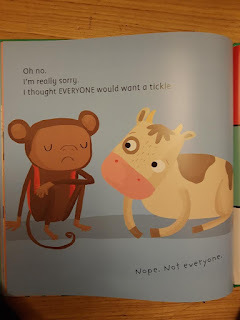
(c) Abigail Tompkins (2020)
And then…
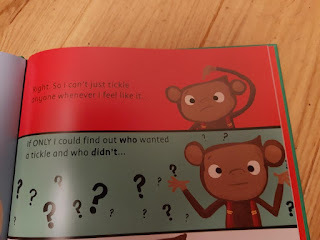
(c) Abigail Tompkins (2020)
The realisation...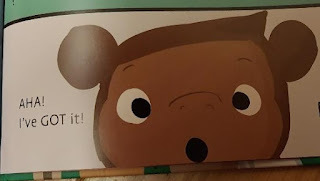
(c) Abigail Tompkins (2020)
It doesn’t mean suddenly that he’s always going to get it completely right and never makes mistakes but it’s that realisation…
I suddenly realised -at the ripe old age of fifty, that
I
must
have
ADHD.
For three months after a family member suggested it for her and me and asked me to do an online test like she’d done I had been in complete denial. I went and did one and the ‘this result strongly suggests you have ADHD’ didn’t even leave me questioning if I had; I simply assumed it wasn’t a good test (though I was totally on board with my family member having it). I took three more tests at various points over the following months (with only the last one feeling in any way like I was doing it to find something out about me and not the wrongness of the test). Obviously everyone must come up looking like they had it. I am similar in my difficulties to quite a few friends and family and surely we didn’t all have it?! Unless, of course, you’re drawn to people with a similar slightly chaotic way of thinking/living…? And unless there’s a large genetic component and actually you might come from an extremely neurodiverse family but you all thought it was just normal (and that it was other people who were different and not you…)
Instantly, loads of my life made sense for the first time. Before there were so many individual things that I really struggled with but hadn’t put together (really MESSY in real life -no idea how to keep a tidy home, and frantic tidying (or hiding away of mess into various cupboards before anyone comes round), always FORGETTING things, including how not to forget things -like writing things down…, not being able to stay FOCUSED -except on certain things (though I could do mindless puzzles for hours, or follow some random research thought down a rabbit hole for hours), my whole pattern of work history when I worked in academia…, massive trouble PRIORITISING, having my work in one of nine places (I counted for this post) because of real difficulties ORGANISING anything, being really messy in my writing scribblings, not being able to FOLLOW even the simplest of DIRECTIONS or INSTRUCTIONS, a shockingly bad PROCRASTINATOR, an almost pathological DIFFICULTY FINISHING things. And then I think about our childhood -and, of course! I could go on (and I do, I could talk for ever, and I’d INTERRUPT you loads, too -another thing I’ve properly realised, or at least admitted to myself until now) but I won’t.
It’s a bit embarrassing to have been so blindingly unself-aware for so many years (I used to be a research developmental psychologist! I’m a writer! Surely being self-aware is pretty important for those jobs and I’ve seen myself as being a pretty self-aware person, so my pride took a bit of a hit). I had become more aware in some respects over the past twenty years or so -mostly since having children) and this had spilled over into my author visits in a really positive way. We play games around embarrassing moments -doing or saying the wrong thing (of which I have a rather than average number) and we talk about why writing is brilliant -because I can be messy, I get to be in charge, I have to let go of perfectionism (for so many years I hated making mistakes and the crippling anxiety that goes with it…), I even do projects with children called ‘I am a work in progress’ and mention about how I was bullied in school for being different, and look good humouredly at all the things I struggled with.
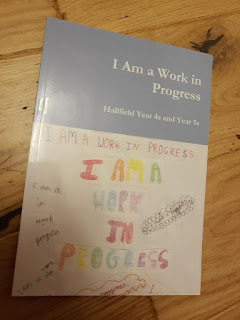
We made a whole book about it! (Thank you to Hallfield Year 4s and 5s)
It was great way of engaging with children and helping them feel better about themselves… And the playing of lots of what if…? games where we go down those crazy rabbit holes and things become ridiculous are loads of fun
but I still hadn’t put all the pieces together…
In the past, I was very harsh on myself and I all always asked the question
why can’t I do things that normal people can do?
I would berate myself that I could do a PhD (even if each chapter/sub-chapter deadline was scarily last minute and I had to stand up whilst writing for the last three days before I handed the whole thesis in as I knew I’d fall asleep if I sat down to write) but I was completely incapable of keeping a room tidy. I’d be furious at myself and think
What’s wrong with you?!
Even now, keeping a room tidy for a few days feels like a bigger achievement than getting a book published because it feels like I’ve finally, inexplicably gained this secret knowledge of how to be normal...
And then I lose it again.
So what does this actually mean for writing?
There are parts of writing and related activities that seem to work pretty well for me (the more sociable bits -where I’m with students, or I’m doing school visits -doing, not organising them; the organising and admin around them are very painful). I can come up with really interesting ideas for books and love doing the research parts where I need to. And the fact that I have trouble with sustaining focus whilst working from home means that no one sees me when I do things in tiny bursts of productivity amongst long periods of zoning out. The productivity can be really productive for short bursts and I have to accept that it does work out sometimes as I DO get books published occasionally! And I have had periods with my accountability partner (2020) where lots of things come together and I have what looks and feels like a massive rush of things going right before it all goes extremely quiet again. And actually, when I am commissioned to write books, or get a book deal, I ALWAYS get them in on time. It’s down to the last minute of course (often literally) but I do deliver when I’ve got a firm deadline. But it comes at a personal cost, relying on adrenaline to make me finish it, and I’ve also missed amazing opportunities because I wasn’t able to prioritise and didn’t turn opportunities into these firm deadlines like publisher deadlines.
But the children’s writing community is lovely (check out SCBWI if you haven't already) and there’s loads of support to be had. I’ve been trying to ‘self-medicate’ with numerous productivity planners and books on getting organised/escaping chaos, and accountability partners and in-person/online write-ins for years without realising it all stems from the same thing. There’s even an ADHD term for the write-ins and similar meetings up: using a body double, where you get someone to be in the same room as you whilst you’re doing something you find difficult to do. The other person doesn’t help you; they’re just there. I find it really hard to get started and to finish things, so having people around makes getting started much easier. And I have a wonderful accountability partner (a fellow picture book author). Now she knows, she’s going to hold me accountable for some of the things I find unbearably difficult -by being my body double. I have about one hour of paperwork I need to do for part of my job each week that’s really simple if you do it straightaway but I have an almost pathological dread of doing it straightaway, so it then takes three or four times as long to do it later. From now on, my accountability partner and I will stay on our zoom call for an hour after our weekly accountability session and she’ll do whatever work she’s working on and I’ll specifically do the thing I can’t bear to do -which is actually a really easy task if there’s someone there.
And soon (pandemic permitting) I'll start back with some in-person write-ins in a local cafe. With write-ins, there’s an element of not wanting to look bad by not writing anything and feeling less inclined to look online as someone will see me, but it’s actually much more than that. My totally illogical anxiety involved in actually getting it started just isn’t there.
I’d really recommend body doubling for reading, too, if you struggle to read, or finish a book. My children asked to read together (not out loud, but silently, in the same space) over lockdown, and it’s actually got me back into reading in a way I haven’t read for over 25 years. I’ve probably given up on five books for every one that I’ve finished when I’m reading them for myself, and the ones I’ve read are mostly young adult books where they’re designed to get you engaged from the first page. I read so much as a child and I absolutely love it again now. Our reading sessions together are highlights of my week.
I realise I’ve written plenty of blogposts relating to aspects of this (especially on procrastination and motivation) and each time it feels that it’s the start of something new (I am an eternal optimist), but it’s different now (no, really!). There’s a difference between thinking something is helpful and knowing it’s necessary. ADHD isn’t an excuse for anything I’ve done (or not done) or do (or not do), but it’s an explanation and I feel like I’m arming myself with knowledge that will equip me really well for writing in the future. Self-awareness is always good when writing authentically, and knowledge about a whole person approach (including good sleep, exercise, nutrition, mindfulness, specific strategies for prioritising, making lists, using a calendar consistently, setting loads of alarms to remind me to do things, etc. and possibly stimulant medication) is a really positive step.
One of the biggest changes in my thinking over the past few weeks is about raising my expectations. I’m naturally a happy person. I am daily extremely grateful for my life and family and friends. But in order to decide that this wasn’t been a huge personality flaw (to believe that I wasn’t lazy and stupid and selfish) and to accept myself for who I am, I did lower expectations of myself quite significantly about ten years ago. If laziness wasn’t the reason I wasn’t writing much (and why I had a messy house) then there wasn’t much I could do about it except accept it. I actually didn’t want to have much more going on writing-wise because I didn’t think I’d be able to cope with the extra workload. But that’s all changed. I feel like I want to do more, now -because if I use the right strategies and get the right support then it’s not an alarming thought to think of having more deadlines from editors. And imagine if I managed to get organised enough to do the right kind of publicity for my books? And if I sorted out a system for doing author visits that didn’t feel like the admin was so grim that it might not be worth it (and where I could do that admin with a kind body double who was just getting on with her work on skype whilst I finished my admin?). (And what about a calm, tidy house?! Now that would be something…)
Waiting lists are notoriously long so I haven’t got an official diagnosis yet (believe me, I’ve refrained from including the dozens of personal stories which would make it feel like I didn’t need to wait for a diagnosis to know!) but apart from stimulant medication which I may or may not try, I can start doing all the other things now. It’s going to be a life-long process (we’re all a work in progress after all...), but I’m enormously relieved and really excited. Next fifty years here I come. And as for the picture book den deadlines? I’m going to find the dates tomorrow and write a year’s worth onto my online calendar which I’m going to check every day. I’ve even set the alarm (with accompanying label) to do it…
Are you a writer with ADHD (I’m guessing there are quite a lot of writers out there!)? If you have any tips for writing with ADHD, please share them below. Many thanks.
Juliet Clare Bell (always called Clare) can be found at www.julietclarebell, though oddly enough, her website needs updating...
August 9, 2021
AN EXCITING TIME FOR NON-FICTION PICTURE BOOKS - plus COVER REVEAL!
One of the reasons I love picture books, is because there is such a fantastic range – from funny to heartfelt to educational and everything in between, there really is something to suit every kind of writer. This Picture Book Den post is going to focus on an exciting subgenre of picture books that feels particularly popular at the moment, with just as much variety – narrative non-fiction picture books. (Plus, there's an exciting cover reveal at the end!)
What is a Narrative Non-fiction picture book?
Just like any strictly fictional text, a narrative non-fiction picture book is a story first and foremost. There might be facts before the story (front matter), facts at the end of the story (back matter), facts throughout… but the primary focus is on engaging characters and a satisfying plot.
This is different from illustrated non-fiction in a picture book format, where text might be arranged by headings, subheading or chapters and can be read out of order.
Here are some of my current favourite examples of narrative non-fiction texts. As you can see, there’s a massive range in style, presentation and topic:
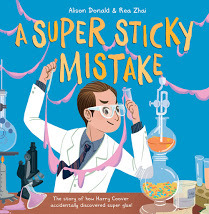
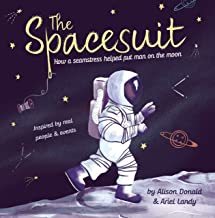
The Spacesuit (Alison Donald, Ariel Landy)
The Spacesuit is a narrative non-fiction picture book inspired by the seamstresses who made the spacesuit for US astronauts in the Apollo missions headed for the moon, based on the life of Ellie Foraker. It includes timelines, fact boxes and facts intertwined in the narrative. Alison is also the author of A Super Sticky Mistake – the story of how Harry Coover invented super glue – another great narrative non-fiction picture book (illustrated by Rhea Zhai).
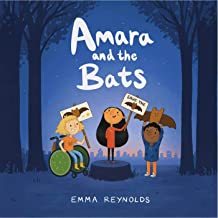
Amara and the Bats (Emma Reynolds)
In this narrative non-fiction text, environmental activism gets a nocturnal twist! Amara and the Bats is Emma Reynold’s debut picture book as an author-illustrator. It’s the story of a little girl who loves bats and is sad when she moves to a new town and finds that bats no longer live there due to loss of habitat. She is inspired by real life youth climate activists to take action and rallies her friends to save the bats! There are bat facts weaved in throughout the story, and lots of fantastic practical steps to take action and help bats in the back, too.
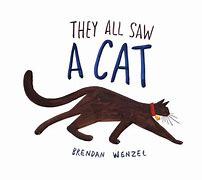
They All Saw A Cat (Brendan Wenzel)
They All Saw a Cat explores what a cat might look like from the perspectives of various animals' points of view. It’s simple in delivery but powerful in concept. I’ve never seen anything like it! There is no front matter or back matter, but the illustrated way the animals perceive the cat is true to life and really makes you think.
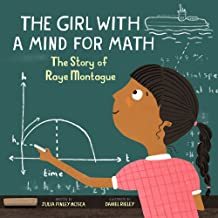
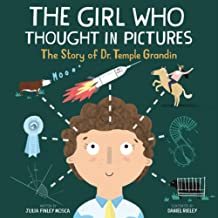

The Amazing Scientist Series (Julia Finley Mosca, D. Reiley, Brendan Wenzel) I’m crossing my fingers that this series of books keeps expanding. The texts explore some of the world’s most amazing female scientists. In addition to the facts there’s a complete biography, colourful timeline and a personal note from the featured artist. These ones are in rhyme, too.
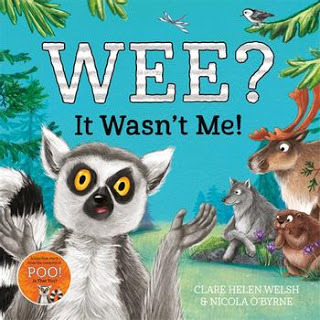
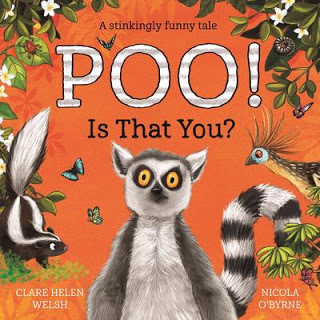
Poo! Is That You? / Wee? It Wasn’t Me! (Clare Helen Welsh, Nicola O’Byrne)
Here are two of my most recent narrative non-fiction texts. Lenny the Lemur is on holiday, first in the Amazon and next in Alaska, when he comes across an unfortunate problem that needs solving. He learns lots of interesting animal facts as he does. The third in this mini-series is slime-based and will be publishing in 2022.
Where did Narrative Non-fiction come from?
The recent rise in narrative non-fiction appears to have come from the US, where invention stories and biography picture books for 3-7yr olds are booming, but blending fact and fiction together in picture book format is not new.
Simon James’ books were a firm favourite in my classroom when I taught as an early years teacher, especially Sally and the Limpet. It’s the story of a little girl who gets a limpet stuck to her finger, and has a gentle message of caring for sea creatures intertwined into a funny and fantastical tale. Dear Greenpeace, also by Simon James, sees the main character (and reader) learn about humpback whales all through letter format. Again, there’s a lovely mix of fact and humour.
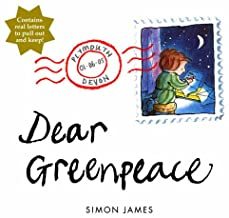
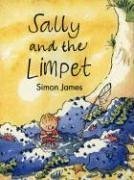
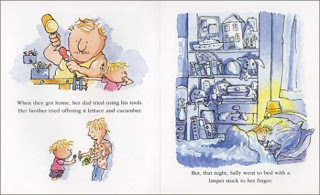
I’m pretty certain narrative non-fiction wasn’t a ‘thing’ when these books were made, but the advantage of adding subtle educational layers to picture books has always been clear. It’s a real selling point for gatekeepers when a text has the potential to impact on young readers long after the last page has turned and when it can be used a springboard for future learning.
Tips for writing Narrative Non-fiction:
Research – Once you have identified your narrative non-fiction concept and suitable ‘way in’, next must come more detailed research. Whilst narrative non-fiction is a story first and foremost, the facts still need to be accurate. Use reliable, first-hand sources where possible, and try to back up each fact with at least three pieces of credible research. It might be possible to link with museums, organisations or contact family members.
Presentation of Facts –Decide whether your facts are going to be presented as fact boxes throughout, as front matter, back matter, an author’s note, whether they will be interwoven into the narrative or a mixture of these.
In my funny Lenny stories, Poo! Is that you? and Wee? It Wasn’t Me!the facts are incorporated into the character’s dialogue and reinforced with fun facts at the end.
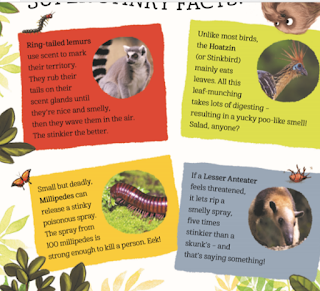
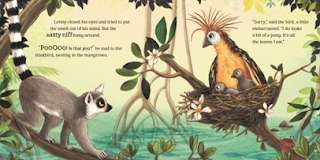
In my lyrical non-fiction with Nosy Crow, the facts are interwoven into the narrator voice and consolidated with facts in the back matter. It publishes next month and is illustrated by none other than the winner of the Waterstones Children's Book Prize 2019, Jenny Lovlie. The story follows a young Arctic tern as she embarks on her annual migration to the Southern hemisphere in search of an endless summer. Children can learn about lots of other animals that also leave their homes for an warmer one. You can take a look inside here: Take a look inside Time to Move South for the Winter - Nosy Crow

In my re-imagining of Cinderella, inspired by the life and work of Lotte Reinger, the factual content is presented in an author note at the end of the book. (Cover reveal at the end of this post!)
In The Spacesuit by Alison Donald and Ariel Landy, the facts are intertwined with the plot but also presented as fact boxes throughout.
Narrative non-fiction picture texts to look out for:
There are some really exciting narrative non-fiction books on the horizon, some due for publication soon. Here’s a look at a couple!
Every Bunny is a Yoga Bunny is a funny, reassuring picture book story about yoga, mindfulness and finding calm, from debut author Emily Ann Davison and award-winning illustrator Deborah Allwright. Yo-Yo is a fidgety, bouncy, can’t-sit-still-EVER type of bunny. Even Grandpa’s yoga class won’t stop her wiggling and giggling! But when Yo-Yo finds herself lost in the deep, dark, shadowy forest, maybe Grandpa’s yoga will help her find the way home . . . With simple yoga step-by-step instruction in the narrative and some poses at the end to practise, children can stretch, breathe and feel calm with Yo-Yo.

And I hope it's ok to announce my real-life inspired story publishing this November with Andersen Press. Described as ‘Cinderella meets paper-cutting, with a strong feminist twist,’ the story is based on the life and work of German film director Lotte Reiniger.
‘Lotte doesn’t believe in happy endings. She lives with her horrible, bossy sisters and her only friends are the exquisite cut-out paper puppets she makes by the light of the moon. But when an invitation to the Palace Spring Ball arrives on their doorstep, Lotte sees her chance to change her life for ever...’
This is a Cinderella re-imagining with a difference where forceful individuality and talent create happy endings not fairy tale magic. Whilst the story is fictional, it was inspired by a real life individual and features an author note at the end. Laura Barrett, whose style is also inspired by Reiniger, is the very wonderful illustrator who has done the most fantastic job bringing the text to life - the artwork is so detailed and there are some wonderful surprises inside. Finally, here is her fantastic cover!
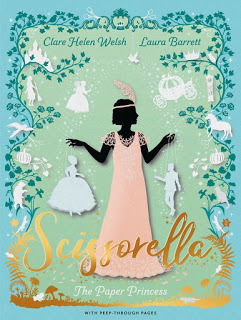
Publishing 4th November 2021 - You can read and see more of Laura's beautiful artwork here Laura Barrett Illustration
If you didn’t love narrative non-fiction picture books before, I hope you do now! Just like in fiction, there’s a huge range; poetic, scientific, silly, serious – something for everyone! Narrative non-fiction texts can cover subjects such as biographies, inventions, events in history, animal adaptations, scientific phenomenon… anything you feel passionate about and that you think would entertain a child. Nothing is off limits if you can find the right age-appropriate angle.
Happy writing!
BIO: Clare is a children's writer from Devon. She writes fiction and non-fiction picture book texts - sometimes funny and sometimes lyrical. Her first book was published in 2015, and she currently has books in development with Little Tiger Press, Quarto, Andersen, Nosy Crow and MacMillan. Her next narrative non-fiction picture book, 'Time to Move South For Winter,' comes out in just a few weeks and has been illustrated by Jenny Lovlie. She also has her first book with Andersen, Scissorella, publishing in November, which is another life-inspired tale. It has been beautifully illustrated by Laura Barrett. You can find out more about Clare at her website www.clarehelenwelsh.com or on Twitter @ClareHelenWelsh.
August 1, 2021
How to Edit A Picture Book Without Cutting Trees by Chitra Soundar
A long time ago when I started writing picture books, I learnt about making dummies before I heard about storyboarding. Either way, both picture book dummies and storyboarding felt too "arty" for me, because I had no art skills. I can barely doodle, or use any craft supplies. Even today! Almost 10 years from when I started, most of my drawing skills are still basic.
But I'm from a software background and if you worked in the corporate world, you'd know that using a presentation software can make or break your career. I was well-versed in Microsoft Powerpoint even then and even more now and sometimes I stray into Keynote (on Macs) as well.
If you are like me and cannot draw and also find it extremely sad to print two lines on a sheet of paper to fold it in, to make picture book dummies, here is my guide to making them on a computer, definitely more eco-friendly.
Check if your PC has Microsoft PowerPoint. Your Mac will definitely have Keynote. You can also use Google Slides which is free.A - Create a presentation of your story
Step 1: Start the presentation software and open a blank presentation.
Step 2: The first slide always comes up as a title slide. That’s what you need too. Enter the title of the book and the author name here. There is a huge positive boost to your self-confidence when you actually type in the title and your name as the author. {Protip: This works brilliantly in kids' workshops too}
Step 3: Insert a new slide and choose the simplest layout - a blank one.
Step 4: Repeat 11-14 times. UK picture book stories are usually told in 12 spreads. US publishers often allow up to 15 spreads.
{Pro Protip: If your story throughline is too thin or your idea doesn't have sufficient story weight, you won't be able to fill 12 spreads with "things that will happen." So creating 12 blank sides gives you an understanding of the work involved.}
Step 5: Cut and paste text into each slide from your word document (if you've already typed it up) or from your notebook if you've already written it.
I usually write my first drafts on paper then transfer them into a document. And then if I can't get the story structure to work or unsure of something, I'll create a presentation and cut and paste to see how it all lays out.
So now you have a presentation, with a title slide and 12 slides after each representing a spread in your picture book.
Step 6: View the story as a slideshow - click through it or set it on a timer. But watch it unfold.{Protip: Use transitions that mimic page turns just for fun! }
So in the above six steps, you've created a different perspective into your picture book. It's another way similar to reading aloud.B - Review your storyAs you are clicking through your story, what should you be watching out for?
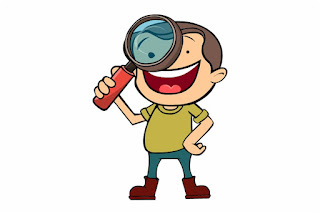 You will see whether some part of the story is too slow and some of it is rushed, ie, pacing. This step will also reveal if your page-turns are working. Do you have a surprise before or after a page-turn? Is there enough anticipation before a reveal?You will see if one spread has more text while others have none. But this is sometimes deliberate while other times, it's a symptom of a pacing issue.How many clicks does it take to get to the actual story? How much scene setting are you doing? How quickly did the story end? Was there an Aaah! moment when the page turned?Now that all the 11-12 spreads have been clicked, can you think of a surprise ending at the last click? Can there be a joke, a twist, an image that will sum up the theme? After the above things have been checked, you will have an idea of what changes you might have to do.
You will see whether some part of the story is too slow and some of it is rushed, ie, pacing. This step will also reveal if your page-turns are working. Do you have a surprise before or after a page-turn? Is there enough anticipation before a reveal?You will see if one spread has more text while others have none. But this is sometimes deliberate while other times, it's a symptom of a pacing issue.How many clicks does it take to get to the actual story? How much scene setting are you doing? How quickly did the story end? Was there an Aaah! moment when the page turned?Now that all the 11-12 spreads have been clicked, can you think of a surprise ending at the last click? Can there be a joke, a twist, an image that will sum up the theme? After the above things have been checked, you will have an idea of what changes you might have to do.There are two options now:
a) Go back to your notebook, document and rewrite the story and come back to the presentation to do another edit.
b) Edit the story in the presentation and then of course you can export it later.
C - How to revise a story in your presentation softwareHow to figure out what to edit and how to edit it?
Descriptions: Often picture book writers put in descriptions that will not be needed when the illustrations are completed. Sometimes the descriptions are required to communicate plot and sometimes it's just a way to translate the story the writer sees in their head.
A good picture book is a marriage of text and pictures and hence it will help to see that working in your drafts as well.
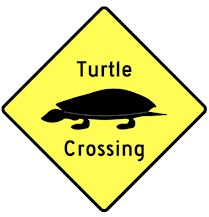
<PROCRASTINATION ALERT!>
In every spread (slide) you see descriptions that are not required, a blue car, a big house etc, try and add images to the slide.
{Protip:You can cut and paste illustrations from google images and then read to see if you still need the words on the page. }
The story must still work without the adjectives and exposition. The story will finish its circuit in the reader's head. So only write those descriptions that you have to be specific about.
For example, if the car has to be red for plot purposes, then add red in the story. Otherwise just say car and let the reader imagine their own favourite colours. The illustrator can suggest their own visuals to help the reader too.
Setup: Do you need an elaborate setup for your story? Go through the presentation again and see how many clicks does it take to get to the "inciting" incident in the story? There is no right or wrong. There is no golden rule. The setup should be as long as necessary for the story.
So keep cycling through the presentation by hiding the exposition slide and see if the story still works. Doesn't work? Sure, unhide your slide. Do you realise you don't need it? Delete that slide (and the text from your story).
ORDER OF EVENTS: As you click through the presentation, keep thinking if there is a causal effect of one slide to another. This happened and so this happened... If not, think about whether there should be. Again, there is no golden rule, there is no right or wrong. You just have to see if you need to connect the dots for the incidents and make them build upon each other.
Go to slide-sorter in your presentation and see the 30000 feet view.
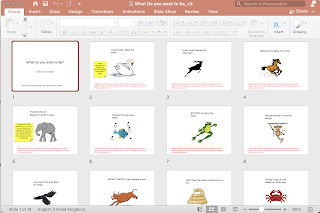
Now move things around if you need to and if you can. Edit the transition sentences when you move around the slides / spreads.
PAGE-TURNS:
Page-turns are cliff-hangers in picture book parlance. Young children (often 3-5 years of age), should want to turn the page and see what's on the next page. So often sentences are not fully finished in a spread, they reveal a surprise when you turn the page. See if there is enough anticipation in the text that motivates the reader to ask questions like
a) Who do you think?
b) What's going to happen?
c) What will it be?
 Page-turns are also good devices to setup causal effect. This happened and so.... turn the page to see what happened next.
Page-turns are also good devices to setup causal effect. This happened and so.... turn the page to see what happened next.{Protip: Hide some slides, edit the text, move around slides - see how the flow works each time by clicking through the entire presentation.}
PACING:
Ideally by clicking through the slides you will be able to check for the following:
How soon do I know who the protagonist is?How quickly will I find out what they want?How soon is something fun going to happen?How much build-up there is to the centre-spread where everything goes BOOM?How quickly did the ending come? Was it satisfactory or did I need a slow-down page for the young reader to take in what just happened?Is there a tag or a button at the end - ie, is there a funny twist or an extra aaah moment after I've turned the last spread?{Protip:Count the slides and the clicks, move things around including text. Build the anticipation using page-turns and make sure the middle spread (say around 6/7th) has a big scene that the illustrator can have fun with. }D - NOW WHAT?After doing all that, you realise you really work better on paper. But you still want to be eco-friendly!
You can print out the presentation in handout form - say 2 or 4 to a page, depending on your eyesight or the size of your magnifying glass. Review everything in one go, then go back to the presentation and edit it. All done?
Then you're ready to export the text back to a document. So you don't have to retype anything you did.
Here are other blog posts on the Picture Book Den that will help you with structure and editing of picture books.
1. A Hero's Journey with Farmer Falgu by Chitra Soundar
2. It's not only the pictures that give picture books their power... by James Catchpole
3. The Clue is in the Name. Editing your PICTURE book manuscript: making every word count by Juliet Clare Bell

Chitra Soundar is an internationally published author of over 50 books for children. Chitra writes picture books and fiction for young readers. Her stories are inspired by folktales from India, Hindu mythology and her travels around the world. Her books have been published in the UK, US, India & Singapore and translated into Chinese, German, French, Japanese and Thai.
Find out more on her website and buy her books here.
July 18, 2021
The First Modern Picture Book Illustrator? By Pippa Goodhart
I’m going to quote Maurice Sendak, writing in 1978 (published in a handsome book called ‘Caldecott & Co. Notes on Books & Pictures’). Talking about Randolph Caldecott, the illustrator, he says, ...
‘Caldecott’s work heralds the beginning of the modern picture book. He devised an ingenious juxtaposition of picture and word, a counterpoint that never happened before. Words are left out – but the picture says it. Pictures are left out – but the word says it. In short, it is the invention of the picture book.’
Sendak then talks (the essays in this book were often speeches) about the ‘honesty’ of Caldecott’s work. ... ‘Caldecott never tells half-truths about life, and his honest vision, expressed with such conviction is one that children recognize as true to their own lives.’
So I went to my bookshelves to look again at my own tatty copy of a Caldecott book.
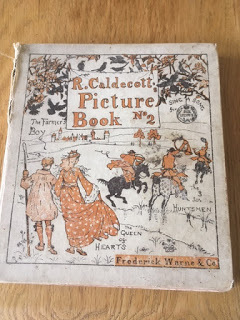
It had been given as a present –
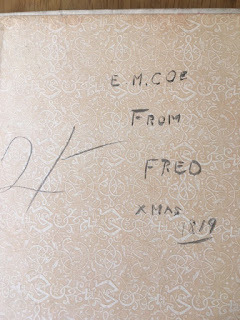
Goodness! 1819 is over two hundred years ago, the year of the Peterloo Massacre, the year when John Keats wrote his ‘Ode To Autumn’, the … Oh, that can’t be right! Randolph Caldecott wasn’t born until 1846, and was contemporary, and friends with, the pre-Raphaelite artists. Fred had clearly got the date back to front, and must have given that two shilling book in 1918, at the end of the First World War. A salutary lesson in how evidence-based ‘history’ can get it wrong!
Never mind. Let’s look inside the book. What joy! The colour plates are beautiful, and it’s clear that bank clerk turned illustrator via night school classes Caldecott really was in the same artistic stream as his friends Millais and Rossetti –

But the real fun is in the little line drawings which add sub-plots and such relatable humanity that we see what Sendak calls the ‘honesty’ of the work. The emotions ring absolutely true, and that is exactly why they are funny. In ‘The Queen of Hearts’ we have a number of sub-plots, making the Queen herself about the least interesting character in the whole thing. A royal child longing for those tarts, and sneakily stealing something himself (the king’s sceptre) that goes unpunished, unlike the luckless knave who is beaten for his crime. And there’s the wonderful tell-tale cat –

But I’m sure it is the naughty knave himself who children must relate to most strongly. The absolute longing for those delicious tarts, solving the problem of where to hide them, then being called to do a job so having to hide them again, ...
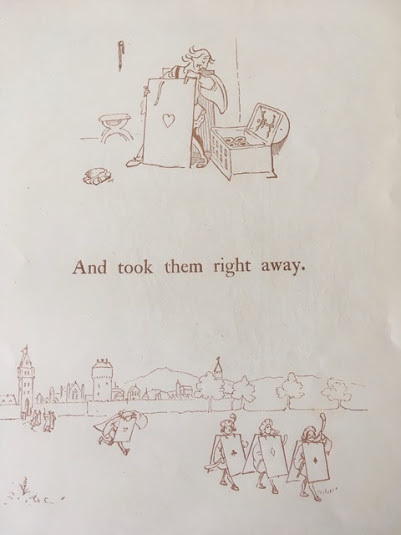
... thinking he’s got away with his crime and will enjoy the tarts in due course, but that sneaky cat has made sure isn't true. We, the book audience, know what the knave doesn't, and soon the knave gets beaten ‘full sore’. At that point we see the children in the story’s sympathy for him, holding back the King of Hearts when he goes to thrash the knave.
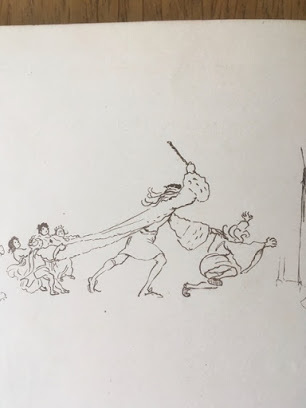
The knave has the agony of being laughed at for his crime, ...
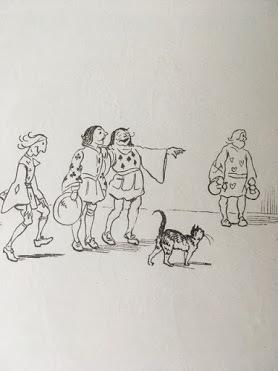
... and seeing everybody else in court scoffing the jam tarts he had wanted. It’s all so, so relatable, even when done in such sketchy fashion!
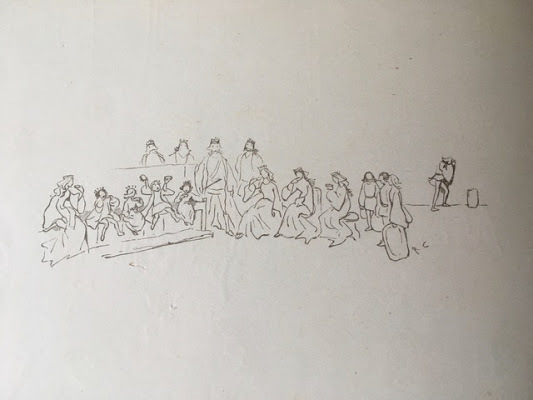
July 11, 2021
How to HOOK in the Reader by Leaving SPACE • by Natascha Biebow
When crafting picture books, I’m always delighted when the end product looks seamless. All that agonizing over the details of story, character, plot, pacing, word and image choices, layout, design, format, typography and so much more is ready to be launched into the big wide world, bound into pages of promise.
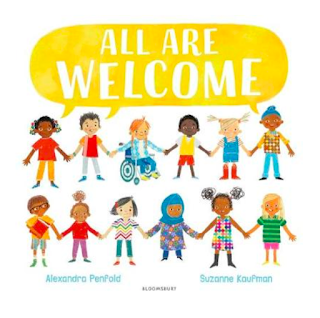 All Are Welcome by Alexandra Penfold and Suzanne Kaufman
All Are Welcome by Alexandra Penfold and Suzanne KaufmanPromise because there is something else that must now happen – when the book lands into the hands of young readers, it must connect.
For a book to deliver that magical, immersive, transportive reading experience that lingers and resonates, the picture book must become more than the sum of its parts, more than just the literal elements on the page. To do this, it needs something key – the reader.
Now, that delicately crafted balance between the words and pictures on the page (seamless, we hope) plays out to make something synergistic – because when the reader gets involved, the child creates the ‘more’.
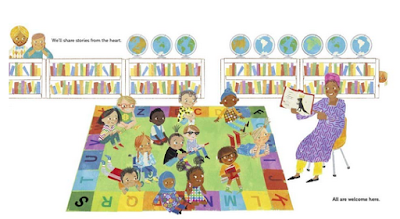 "We share stories from the heart."
"We share stories from the heart."From All Are Welcome by Alexandra Penfold and Suzanne Kaufman
The reader is tasked with actively encoding the words and the pictures, listening and looking, making connections and filling in the gaps to make meaning.
To do this, authors and illustrators need to leave SPACE for the reader:
In the PICTURES
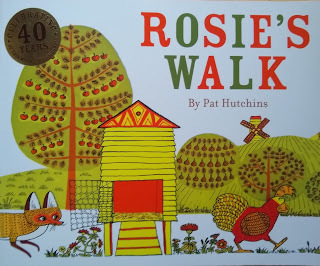 Rosie's Walk by Pat Hutchins is a classic example of where a visual narrative
Rosie's Walk by Pat Hutchins is a classic example of where a visual narrative allows space for readers to participate and add to the story narrative.
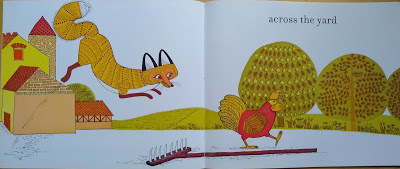 The minimal text tells one story, while the pictures tell another . . .
The minimal text tells one story, while the pictures tell another . . .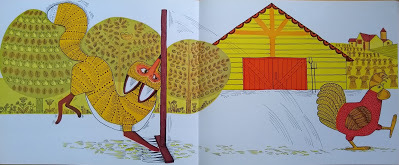 . . . creating lots of humour!
. . . creating lots of humour!In the WORDS
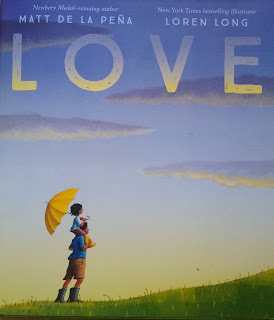 Love by Matt de la Peña and Loren Long
Love by Matt de la Peña and Loren Long
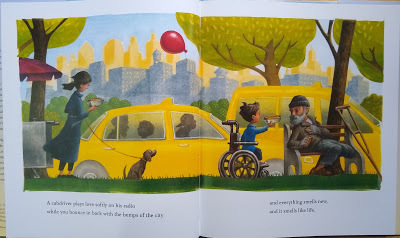 The open-ended, lyrical text allows young readers to imagine each moment and
The open-ended, lyrical text allows young readers to imagine each moment andadd to an individualized interpretation of what 'love' is:
". . . everything smells new, and it smells of life."
In this instance, the illustrator depicts a boy sharing a hotdog with a man on a bench,
but the reader might interpret these words in many different personal or imaginary ways.
In the MESSAGE
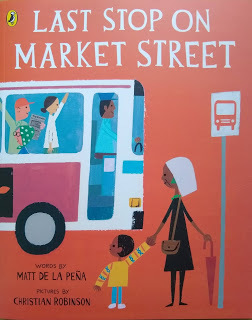 Last Stop on Market Street by Matt de La Peña and Christian Robinson
Last Stop on Market Street by Matt de La Peña and Christian Robinson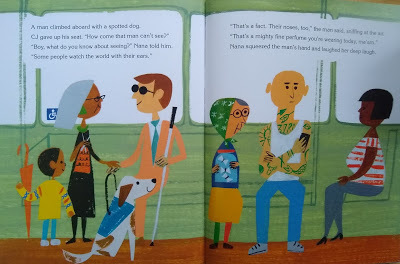 The boy in this story is going on a bus journey with his grandmother - where?
The boy in this story is going on a bus journey with his grandmother - where? The vivid details included in text and illustrations encourage the reader to join in
in creating the meaning, in building up the sense of the characters and their
community, and filling in the special relationship between CJ and Nana.
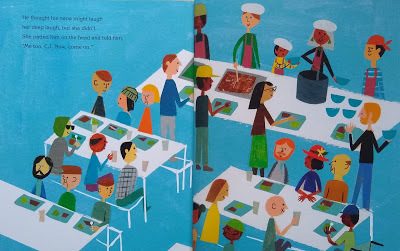 Building on this, in the poignant final scene, CJ is glad to
Building on this, in the poignant final scene, CJ is glad to be with his community of familiar faces –
the words & pictures allow space for readers
to figure out where they are and why it matters
without needing to be told in an overt message.
Even in the FORMAT.
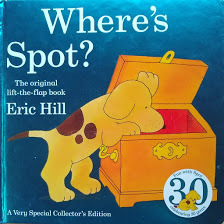 Where's Spot? by Eric Hill is a pre-school classic!
Where's Spot? by Eric Hill is a pre-school classic!
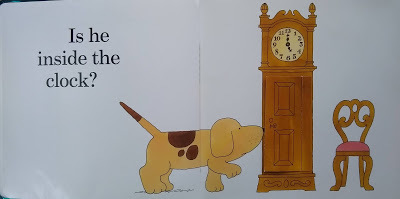 A lift-the flap guessing game format is delightful fun to share with the youngest readers
A lift-the flap guessing game format is delightful fun to share with the youngest readers and leaves lots of space for dialogue and for the reader to
imagine possibilities while interacting with and adding to the story.
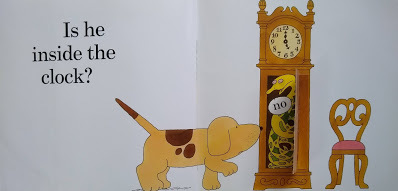 Surprise! The SNAKE is in the clock, not Spot!
Surprise! The SNAKE is in the clock, not Spot!
HOW do authors do this? (And how can you do it if you’d like to write amazing picture books?)
WELCOME the reader in
 One Smart Fish by Chris Wormell
One Smart Fish by Chris Wormell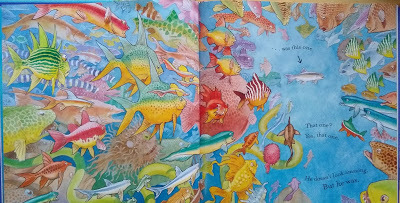 This spread at the beginning of the book introduces the main character, one 'Smart Fish',
This spread at the beginning of the book introduces the main character, one 'Smart Fish', who looks so ordinary - how could he be a hero? the reader might wonder.
I wonder WHY he's amazing? The author invites the reader to engage with the story
and welcomes them into the narrative to go on a journey together.
Invite readers in to be part of and even engage in creating the story.
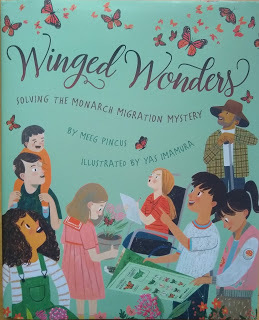 Winged Wonders: Solving the Monarch Migration Mystery
Winged Wonders: Solving the Monarch Migration Mysteryby Meeg Pincus and Yas Imamura
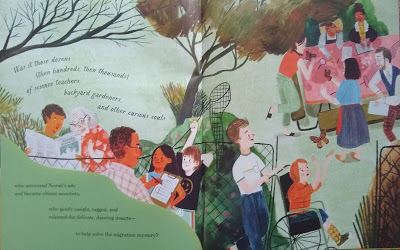 In this story, Pincus invites readers to participate in the question of who solved the age-old
In this story, Pincus invites readers to participate in the question of who solved the age-oldmystery of where the monarch butterflies go every year? In a series of spreads, the
open-ended questions allow readers space to engage with the narrative,
accumulating facts as they turn the pages to come to their own conclusion –
more than the sum of its parts.
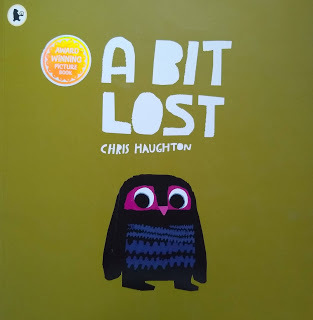 A Bit Lost by Chris Haughton
A Bit Lost by Chris Haughton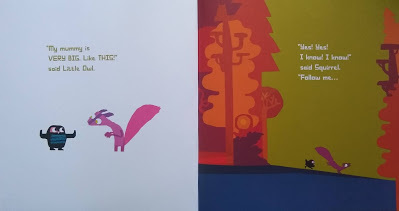 Squirrel is trying to help Owl find Mummy. In each sequence, Owl describes Mummy:
Squirrel is trying to help Owl find Mummy. In each sequence, Owl describes Mummy:"My mummy is VERY BIG. Like THIS!" The author allows space for the reader
to be part of the story and imagine how Mummy might look with these attributes.
The pictures also allow space for the reader to imagine both Mummy's
appearance and guess what might come next. And because the reader
is part of the narrative, when they turn the page to find . . .
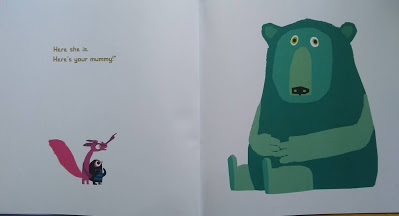 . . . a bear (!) it's instantly funny.
. . . a bear (!) it's instantly funny. The pictures here allow space for the reader to reconsider their guess
and delight in the joke when Squirrel mistakenly asserts, "Here's your mummy!" - since
young readers will know an Owl's mum looks nothing like this -
but also readers will empathise with Owl's disappointment at still not
being reunited with Mummy.
Can you create an OPENING IN THE NARRATIVE where young readers can find meaning?
AVOID over describing: the delicate balance between words and pictures takes craft to achieve – the story must stand on its own when read aloud, but also leave space for the pictures and for young readers’ interpretation. The choice of what to include is just as important as what to leave out. It may take some often-frustrating tinkering.
 Bob Goes Pop! by Marion Deuchars
Bob Goes Pop! by Marion Deuchars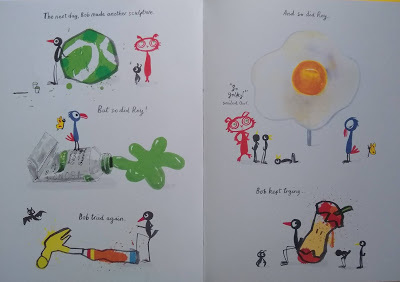 In this story that explores the theme of what makes a good artist, Bob is an artist who
In this story that explores the theme of what makes a good artist, Bob is an artist whogets into a argument with a famous sculptor called Roy. Bob says Roy's art is just
everyday objects except bigger. Roy bets Bob he couldn't even make a sculpture if he tried!
In this scene, every time Bob creates a work of art, Roy's is seemingly better.
The author allows space in the pictures for readers to look closely and intuit this.
Bob's splodgy rough round the edges artwork gives an impression that it is
less slick than Roy's, even through the text doesn't tell readers this.
Looking closely at Bob's body language in the pictures also allows space for the
reader to connect with Bob's emotions and understand how the main
character's frustration is building until his desperation leads him to cheat.
It is important to know the backstory of your narrative and your characters’ world and, above all, your character’s motivation, but then to choose carefully what you will include. Use specific, vivid details, but only share those that will give meaning to the story.
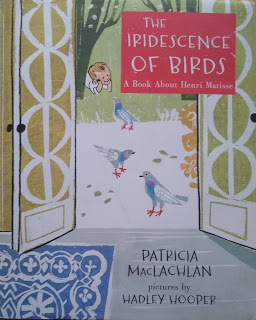 The Iridescence of Birds by Patricia MacLachlan and Hadley Hooper
The Iridescence of Birds by Patricia MacLachlan and Hadley Hooper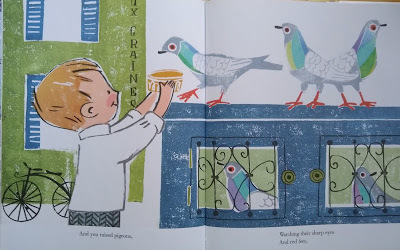 In this nonfiction picture book about the artist Henri Matisse,
In this nonfiction picture book about the artist Henri Matisse, the author poses one long question - why do painters paint what they do?
Carefully choosen details in the words and pictures on each spread
illustrate vivid and specific everday experiences that influenced the artist
to eventually produce his colourful collage artwork.
The narrative is filled with spaces, where the reader
must fill in the gaps to make the sum of the whole to arrive at
the inspiring 'a-ha' moment at the end.
Conversely, avoid the pitfall of including too little information. If there isn’t enough context, emotion, or details, readers have nothing to hold on to so they won’t be invested enough in the story to add meaning. It's key to set up the action to arrive at a satisfying ending.
AVOID overstating the story’s theme or message. This leaves no space for the reader! If the author has done their job well, there is no need to tell readers what the take-away is, because the plot and character’s emotional journey to overcome the plot problem and navigate high stakes will serve to create a feeling and a take-away meaning that the reader is able to intuit.
Invite the reader to
PREDICT what will come next
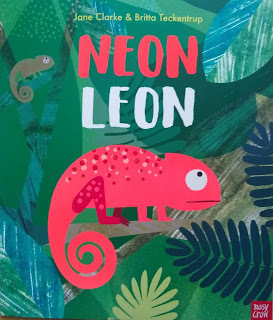 Neon Leon by Jane Clarke and Britta Teckentrup
Neon Leon by Jane Clarke and Britta Teckentrup Neon Leon is a chameleon who doesn't fit in. Throughout the story, the author
Neon Leon is a chameleon who doesn't fit in. Throughout the story, the author creates space for young readers to interact with the main character's actions
and empathize with how he's feeling. In this spread, Neon can see something that might
be a hint of something the same colour as him. Is this the answer he's been looking for?
The text ends with an ellipses (ooh, I wonder...), which when combined with the page turn,
adds space for the reader to engage and predict what might come next.
OBSERVE the pictures for narrative clues that will advance the plot and
your characters’ motivation story arc.
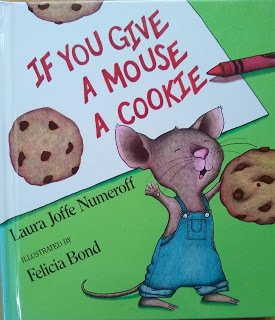 If You Give a Mouse a Cookie by Laura Joffe Numeroff and Felicia Bond
If You Give a Mouse a Cookie by Laura Joffe Numeroff and Felicia Bond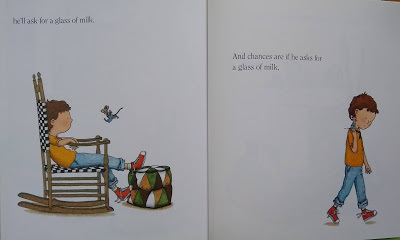 All day long, the boy has been following the mouse, making sure it has what it needs.
All day long, the boy has been following the mouse, making sure it has what it needs. The simple words underline a multi-layered visual narrative in which the mouse
goes from one thing to the next, starting with a cookie
that needs a glass of milk that needs a straw and so on,
all the way full-circle to the ending, where the mouse is thirsty and needs . . .
 . . . . a glass of milk! The narrative leaves space for the reader to look closely at the pictures,
. . . . a glass of milk! The narrative leaves space for the reader to look closely at the pictures,and add depth, nuance and humour to the interpretation of the story.
The emotional journey of both the mouse and the boy and their relationship
is largely apparent in the pictures.
And importantly, leave space for ‘I WONDER . . . “ so readers can have the pleasure of that a-ha moment and of working stuff out for themselves, filling in the meaning.
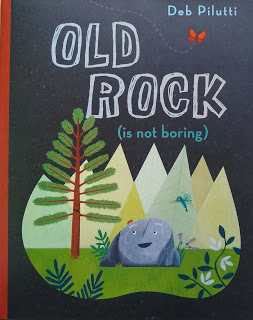 Old Rock (is not boring) by Deb Pilutti
Old Rock (is not boring) by Deb Pilutti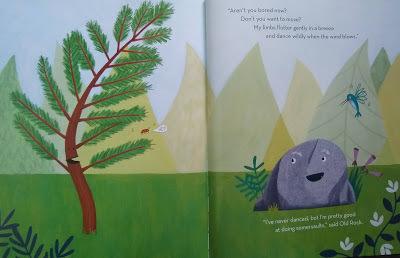 Old Rock has been sitting on the same spot at the edge of a forest for a long time.
Old Rock has been sitting on the same spot at the edge of a forest for a long time. Tall Pine, Hummingbird and Spotted Beetle are sure it must be very boring.
But Old Rock has surprisingly actually had a very interesting and exciting life!
Here, Old Rock tells them he's pretty good at doing somersaults.
It seems inconceivable given how Old Rock looks on the page here.
The page turn is a powerful tool to create space.
This pause allows young readers wonder and imagine what Old Rock
might look like doing somersaults.
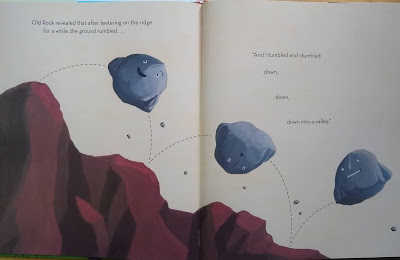 A bit like this perhaps . . .
A bit like this perhaps . . . 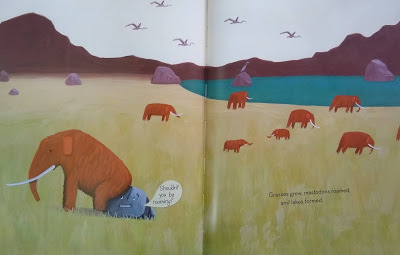 . . . but perhaps unexpectedly landing like this!
. . . but perhaps unexpectedly landing like this! In this spread, the reader can use the space left by the minimal words to imagine how rock
might have felt when he landed here after his exciting somersault adventure,
and what it would have been like living during the time mastodons roamed the Earth.
Importantly the reader might say, "I wonder . . . where Old Rock might go next
and where he might end up after that?"
To do all this, is to TRUST in the reader.
That wonderful synergy that you get in an excellent picture book must come from the fine balance between the words and the pictures, but also from the SPACE creators allow for the reader.
What examples from your favourite picture books and those you’ve created can you share with our blog readers?
__________________________________________________________________________________________
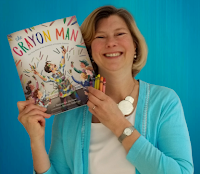 Natascha Biebow, MBE, Author, Editor and Mentor
Natascha Biebow, MBE, Author, Editor and Mentor Natascha is the author of the award-winning The Crayon Man: The True Story of the Invention of Crayola Crayons, illustrated by Steven Salerno, winner of the Irma Black Award for Excellence in Children's Books, and selected as a best STEM Book 2020. Editor of numerous prize-winning books, she runs Blue Elephant Storyshaping, an editing, coaching and mentoring service aimed at empowering writers and illustrators to fine-tune their work pre-submission, and is the Editorial Director for Five Quills. She is Co-Regional Advisor (Co-Chair) of SCBWI British Isles. Find her at www.nataschabiebow.com
July 4, 2021
A look at Cautionary Tales with Mini Grey
How much violence is the right amount of violence in picture books? Or is it none at all? Is it OK for violent words, but not okay for violent pictures? And if so, does this mean pictures are more powerful than words?
I came upon this Amazon review of my version of Hilaire Belloc’s Jim: for this reviewer the depiction of a severed head in Jim - was clearly unacceptable.
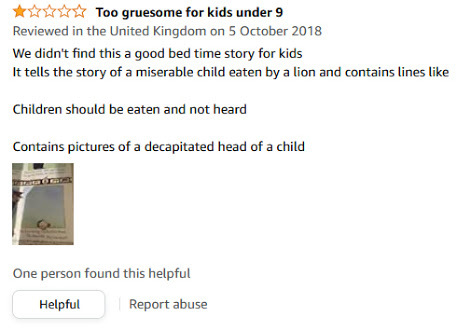
Here’s the moment in full:

Maybe I’d have been wiser to depict the head less gorily.
In her Jim illustration, Posy Simmons shows just pure head sitting like a bun on the ground at the zoo. (I love the stern words the Honest Keeper is having with Ponto the Lion in the background.)
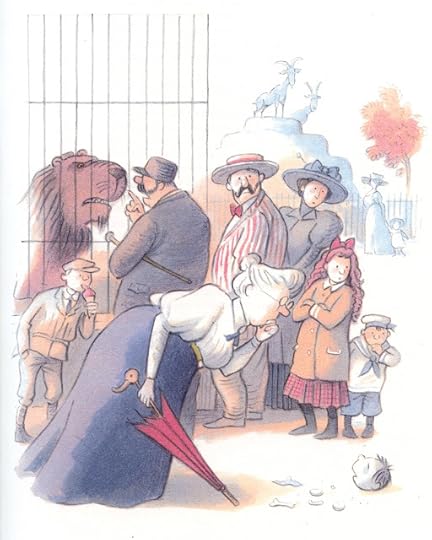
Some of the very first children’s books were highly moralising tales of children being good and bad, intended to be extremely improving. Here’s a scene from William Carus Wilsons’s Child’s First Tales (c. 1829).

It encourages us to have a really good look at a naughty girl who is having an epic stroppy meltdown (worthy of Barbara Throws a Wobbler.) "Oh how cross she looks!"
 Barbara Throws a Wobbler, a fantastic book by Nadia Shireen
Barbara Throws a Wobbler, a fantastic book by Nadia ShireenBut the bad child doesn’t have a chance to learn to calm down and put things in perspective (as Barbara does), because a sentence later God strikes her dead. Reader, you’ve been warned.
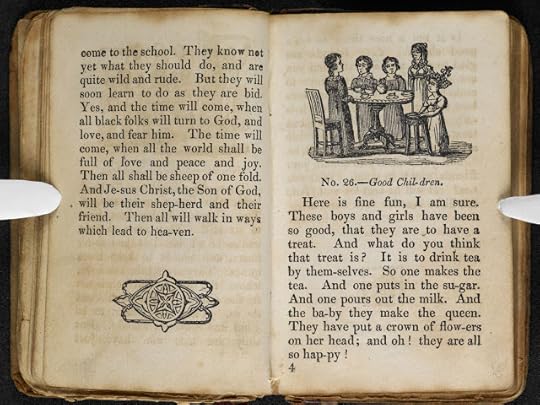
In contrast, above right are some good children. They’ve been so good that they’ve earned a special treat. Which is to be able to drink tea by themselves. So here they are drinking tea, still being good, and all so happy, and not being struck dead by the Almighty.
So these type of children’s books are what Heinrich Hoffman was taking the mickey out of when he created Struwwelpeter.
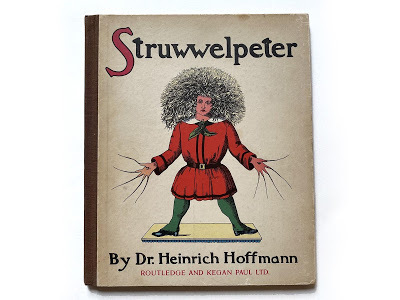
In 1844, Hoffmann – a doctor and writer in Frankfurt – was struggling to find a book to give his three-year-old son Carl for Christmas. Tired of stern ‘moralising stories’, he bought a blank notebook and filled it with his own bizarre tales and cartoonish drawings. These were probably inspired by the stories he told to entertain young patients.
https://www.bl.uk/childrens-books/articles/fear-in-childrens-books
And Hoffman’s pages are quite innovative.

Here’s Harriet going up in flames after playing with matches, accompanied by a sort of Greek chorus of wailing cats who end up projectile-weeping on her ashy remains.

And here is Augustus being reduced from a fine bouncing boy to a stick man in a comic-book type sequence. And it only takes five days without soup to kill Augustus. I think Hoffman was definitely intending to make his children laugh.
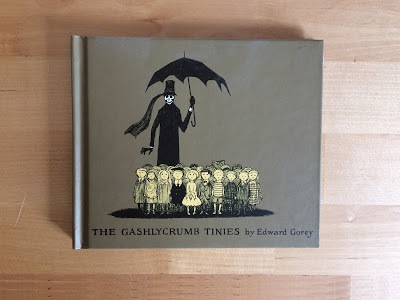
One inheritor of Hoffman’s black humour is perhaps Edward Gorey. His unfortunate Gashlicrumb tinies don’t really have a chance to learn anything before having their lethal alphabetical mishap. Here are Amy, Titus and Zillah.

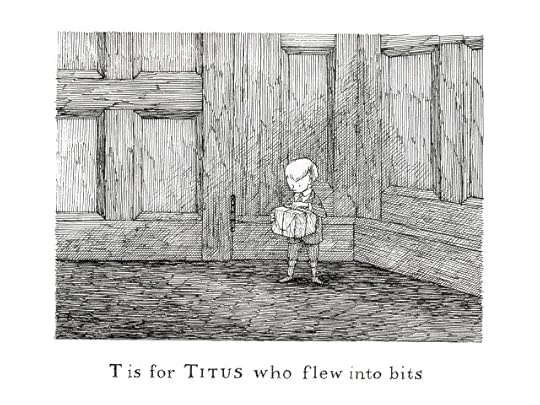

(I really sympathise with Zillah as my gin consumption was a bit enthusiastic over lockdown.)
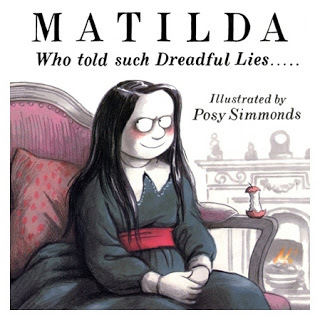
So now we get to Hilaire Belloc. The great thing about Belloc’s cautionary tales is he tells you right at the beginning how the child is going to die. For example:
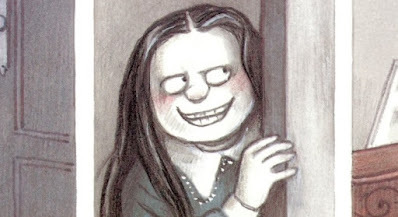
MATILDA
Who told Lies,
and was Burned to Death.
Here’s Posy Simmonds’ Matilda. She is telling an enormous lie.

Matilda told such Dreadful Lies,
It made one Gasp and Stretch one’s Eyes;
But have a really good look at Posy’s picture. Matilda’s aunt is so distracted she’s pouring tea into her lap, the butler looks like he might just drop the cake, the gentleman has gone bright red, and the dog looks like its eyes are going to pop out. What OUTRAGEOUS WHOPPER did Matilda just say? It’s so wonderful. But part of the inspiration for this scene from Posy Simmons is the sheer understatement from Belloc who leaves the content of the lies completely to our imagination.

Here is Matilda’s Aunt’s house burning down. It’s such a gloriously elegant inferno. You can have a look at more here:
https://tygertale.com/2013/07/25/the-other-matilda/
As a child I loved the Belloc Cautionary Tales and learned some by heart – they are brilliant for performing out loud. One of the Bellocs I learned was Rebecca (who slammed Doors for Fun, and Perished Miserably). Ages ago I made a book of Rebecca (for Fun) – I thought a book full of doors could be good. Here are some pages:




Later I was drawn to Belloc’s Jim (who Runs Away from his Nurse, and is Eaten by a Lion)– it was like a delicious present full of fantastic things to draw: tea and cakes and jam, and slices of delicious ham and chocolate with pink inside. But there’s something about the pink inside the chocolate that might be a bit dangerous, a bit like poison.

Poor Jim doesn’t do anything really naughty. He is plied with sweets and treats but isn’t allowed any freedom – so the one time when he successfully runs away, it’s into a lion’s paws at the zoo.

And this zoo is the world’s safest zoo.

In Jim there is stifling safety, many hands, distant parents…
…so could the message really be about the dangers of absolute safety and not getting a chance to experiment with freedom in a potentially dangerous world?
And the Belloc voice is one of breath-taking understatement - which lets your imagination fill in the gaps. Look at what the adults are doing – are they the real culprits?

And there’s useful information on the correct sequence to eat a child bit by bit (feet upwards).

Belloc's Cautionary Tales - could they be written today? Looking to writing in the tradition of Belloc: first stop could be Roald Dahl.
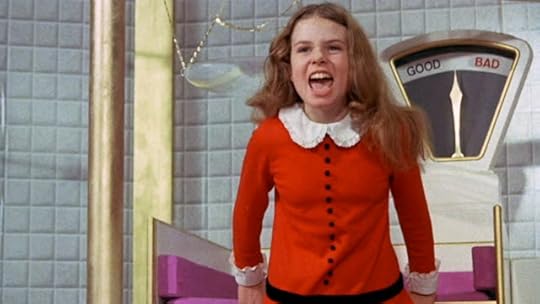
Look at the 5 nasties in Willy Wonka. Augustus Gloop, Violet Beauregard, Veruca Salt, Mike Teevee: a Cautionary Tale, every one.
Here's my Chocolate Factory Chocolate Box, with the Willy Wonka Children immortalised in chocolate:

I have to confess I stopped reading David Walliam’s books with the Demon Dentist. But cautionary tales is a perfect arena for Walliams to unleash mayhem. David Walliams' World’s Worst Children – it’s interesting to look at protagonists. One who is just unrelentingly awful and doesn’t change is boring; discovering a useful quality can steer towards a happy end. Or else a glint in the eye of the awful person can make the whole bloodbath worthwhile (as in Matilda?)

Walliams' cautionary tales seem to be an exploration of what happens if you take something to the absolute extreme. There are children who have problems that aren’t their fault – like the dribbler or the sleeper – is it fair to punish for badnesses that aren't deliberate?.

Less is more. What made me laugh was Earnest Ernest and his photograph album of traffic lights and copies of Spoon Monthly. But then, I'm a fan of spoons and if Spoon Monthly was available, I'd be a subscriber.
In the usual picture book arena the reader is able to travel through the dangerous woods to the happy end. But in Cautionary Tales there’s no happy end…well, usually.
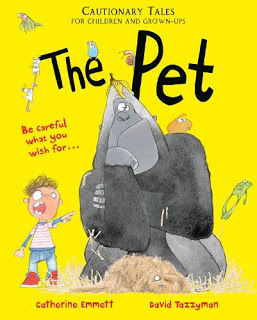
In Catherine Emmett and David Tazzyman’s hilarious The Pet, Digby is a demanding Wanter of pets but a negligent Tender of pets. Cautionary Tales are for children and for their grown-ups – as it says on the cover. So grown ups – pay attention!
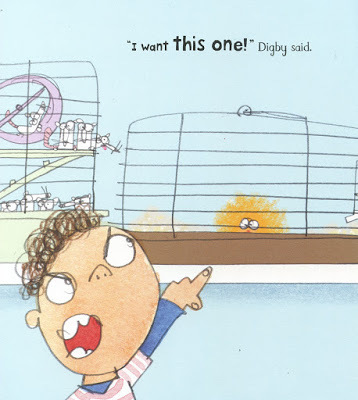

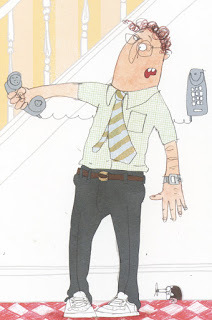
I love the Flea Circus on Doris the Pet Shop owner's counter!
Look to Daddy whose hair turns slightly grey but who always agrees to the demands. (I’m getting a whiff of Veruca Salt’s Dad here)
But the ending is not (SPOILER ALERT!!) fatal for Digby – a bit more like a Not Now Bernard-style role reversal. The surprising hero is Digby’s final pet, who turns out to be an excellent organiser.

I have the complete Cautionary Tales by Belloc, and Matilda, Jim and Rebecca are streets ahead my favourites. Reading through the rest of them rapidly gets a bit exhausting. So they’re a bit like a box of chocolates – once you’ve picked out your favourite ones, chomping through the Coffee & Crab Cream and the Nutmint-Cracknel just gets tedious and makes you feel mildly queasy.
 So a little goes a long way, with Cautionary Tales. And the last word on depicting decapitation might have to go to Hilaire Belloc.
So a little goes a long way, with Cautionary Tales. And the last word on depicting decapitation might have to go to Hilaire Belloc. When asked: “Is it true?” he replied, dryly:
And is it True? It is not True.
And if it were it wouldn’t do,
For people such as me and you
Who pretty nearly all day long
Are doing something rather wrong.
Because if things were really so,
You would have perished long ago,
And I would not have lived to write
The noble lines that meet your sight,
Nor B.T.B. survived to draw
The nicest things you ever saw.
June 27, 2021
Picture Books - a Lifetime Love by Jill Atkins, Guest Blogger
I’ve always loved picture books, since my own childhood, when I was lucky enough to have a mother who loved children’s books; then sharing them with my own children and grandchildren, as well as enjoying sharing the pleasure picture books give when I was teaching. Some favourites have stayed with me. But what do these books have that make me admire/love them? I’ll try to explain.
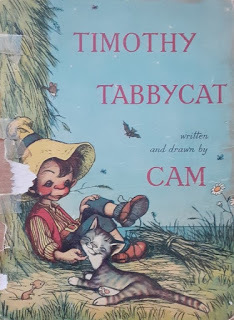
Timothy Tabbycat written and illustrated by Cam is from my childhood. It’s about a quest to help a hare that has been captured by two witches called Mrs Longtooth and Mrs Snatchangrab. It was terrifying yet I loved it! Still do! It’s now classed on a certain website as an ‘Extraordinarily Rare Antique Children's Book’! That puts me in my place!
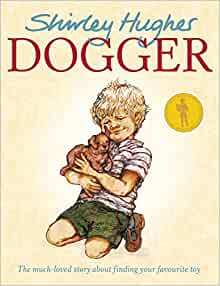
Dogger, written and illustrated by Shirley Hughes is a classic. It’s guaranteed to make me cry every time I’ve read it to my children, grandchildren, a class of children... or just treat myself to the umpteenth time on my own. It’s the part where Bella offers Dave her newly-won bear instead of his lost favourite cuddly, Dogger, that gets me. Her act of kindness is so touching. Dogger must be one of my favourites of all time!
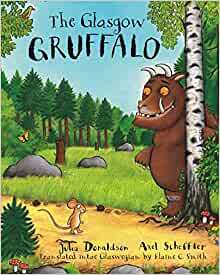
The Gruffalo by Julia Donaldson - Who could not admire The Gruffalo with its perfect rhythm, rhyming and scanning, its attractive illustrations by Axel Scheffler and the story of the clever, brave young mouse? For me, it’s a ‘wish I had written it’ book.

A more recent pleasure is Bonkers about Beetroot by Cath Jones. It’s about a wonderful zebra character that is determined to save the day when the zoo is scheduled to close. I love the bold illustrations by Chris Jevons, and the great twist at the end of the story... not forgetting the grumpy penguin, of course!! It’s a truly bonkers book!
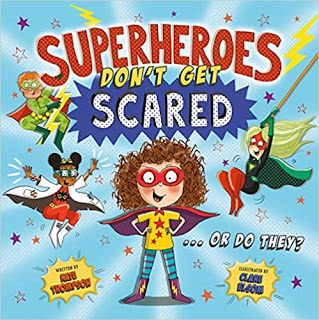
Superheroes don’t get scared... or do they? This is a recently published picture book, Kate Thompson’s first. With an amazingly funny text and vibrant illustrations by Clare Elsom, it has a brilliant message – it’s OK to be frightened!
There are so many picture books that I have loved over the years and it’s impossible to name them all, but a wish has always been lurking in my mind: How fantastic it would be to have my own picture book published! I’ve tried, honest!
I began making up stories when I was a child, telling them to my younger brothers when they were in the bath! And I was praised for my story writing all throughout school, so I suppose this was the start of my desire to have a picture book published.
Then, having been a teacher for many years, most of the time in Reception Classes, I began writing simple reading books some years ago, purely because I didn’t feel there was enough interesting and stimulating material out there at the time to give readers the incentive and stimulation to learn the sometimes impossible skill of reading. None of my efforts was published then, but I kept writing and eventually, my first book came into being: Cooking with Rabbit.
That was the first of many and I’ve now passed 150 published books with a variety of publishers and at a variety of levels and a variety of genres, from a pre-reader with no words... through Early Readers that are very strictly based on phonics (very hard to write, but I love the challenge!); different levels of fiction and non-fiction ‘reading books’ for young children; Science and English workbooks; four historical books based on different periods of history; to books for reluctant or struggling teenagers and adults.
But none of these is a picture book!
During over 25 years of writing for educational publishers, I’ve attempted many times to write picture book texts to no avail. So, when yet another rejection email arrives in my inbox, or worse still, when there’s no response at all, I often ask myself, ‘Should I persevere with my attempts to get one accepted?’ Or...
‘Stick to what you know,’ is the advice many people give, so that’s what I’ve mainly been doing all this time. I’m fully aware that writing a picture book is a very different skill to writing that required for writing a ‘reading book’. The illustrations in reading books need to match the text, while pictures in a picture book add a new dimension to a story.
So, I’m sure you can imagine the thrill and elation when the acceptance came! How it happened in the end was ironic really. I sent in a text for an early reader and guess what! My editor loved the story and wanted the text adapted for a picture book! Yay! My first picture book, Raccoon and the Hot Air Balloon, illustrated wonderfully by Kristen Humphrey, is being published on 28th June!
